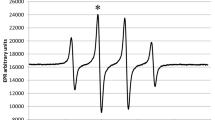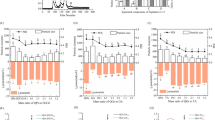Abstract
The purpose of this study was to evaluate the antioxidant activity of Maillard reaction products (MRPs) in both aqueous and ethanolic glucose-glycine oligomer solutions. The reduction in pH was higher in aqueous MRP solutions than ethanolic MRP solutions. The samples in ethanolic MRP solutions had greater Abs294 nm and Abs420 nm than those in aqueous MRP solutions. The ferrous ion chelating activity of all MRP samples was much higher than the cupric ion chelating ability in both aqueous and ethanolic solutions. The antioxidant activity in ethanolic MRP solutions was higher than that in aqueous MRP solutions. MRPs derived from the diglycine were found to be effective antioxidants in different in vitro assays with regard to the ABTS and DPPH radical scavenging activities, and ferric reducing/antioxidant power.
Similar content being viewed by others
References
Baltes W, Franke K, Hortig W, Otto R, Lessig U. Investigations on model systems of Maillard reactions. Prog. Food Nutr. Sci. 5: 137–145 (1981)
Ledl F, Severin T. Formation of colored compounds from hexoses. Z. Lebensm. Unters. F. A. 175: 262–265 (1982)
Ledl F, Hiebl J, Severin T. Formation of colored β-pyranones from pentoses and hexoses. Z. Lebensm. Unters. F. A. 177: 352–355 (1983)
Hofmann T. Studies on the relationship between Mw and the color potency of fractions obtained by thermal treatment of glucose/amino acid and glucose/protein solutions by using ultracentrifugation and color dilution techniques. J. Agr. Food Chem. 46: 3891–3895 (1998)
Mori N, Bai Y, Ueno H, Manning J. Sequence-dependent reactivity of model peptides with glyceraldehydes. Carbohyd. Res. 189: 49–63 (1989)
Lu CY, Hao Z, Payne R, Ho CT. Effects of water content on volatile generation and peptide degradation in the Maillard reaction of glycine, diglycine, and triglycine. J. Agr. Food Chem. 53: 6443–6447 (2005)
Oh YC, Shu CK, Ho CT. Some volatiles compounds formed from thermal interaction of glucose with glycine, diglycine, triglycine, and tetraglycine. J. Agr. Food Chem. 39: 1553–1554 (1991)
Hartman R, Meisel H. Food-derived peptides with biological activity: From research to food applications. Curr. Opin. Biotech. 18: 163–169 (2007)
Alfawaz M, Smith JS, Jeon IJ. Maillard reaction products as antioxidants in precooked ground beef. Food Chem. 51: 311–318 (1994)
Yen GC, Hsieh PP. Antioxidative activity and scavenging effects on xylose-lysine Maillard reaction products. J. Sci. Food Agr. 67: 415–420 (1995)
Anese M, Manzocco L, Nicoli MC, Lerici CR. Antioxidant properties of tomato juice as affected by heating. J. Agr. Food Chem. 79: 750–754 (1999)
Wang L, Xiong YL. Inhibition of lipid oxidation in cooked beef patties by hydrolyzed potato protein is related to its reducing and radical scavenging ability. J. Agr. Food Chem. 53: 9186–9192 (2005)
Dinis TCP, Madeira VMC, Almerida LM. Action of phenolic derivatives (acetoaminophen, salycilate, and 5-aminosalycilate) as inhibitors of membrane lipid peroxidation and as peroxyl radical scavengers. Arch. Biochem. Biophys. 315: 161–169 (1994)
Benzie IFF, Strain JJ. The ferric reducing ability of plasma (FRAP) as a measure of antioxidant power: The FRAP assay. Anal. Biochem. 239: 70–76 (1996)
Re R, Pellegrini N, Proteggente A, Pannala A, Yang M, Rice-Evans C. Antioxidant activity applying an improved ABTS radical cation decolorization assay. Free Radical Bio. Med. 26: 1231–1237 (1999)
Ogura K, Nakayama M, Nakaoka K, Nishihata Y. Spectroelectrochemical and EQCM studies on the oxidation of glycil-peptides in alkaline medium. J. Electroanal. Chem. 482: 32–39 (2000)
Chuyen NV, Kurata T, Fujimaki M. Studies on the reaction of dipeptides with glyoxal. Agr. Biol. Chem. Tokyo 37: 327–334 (1973)
Reynols TM. Non-enzymatic browning. Sugar-amine interaction. p. 219. In: Carbohydrates and Their Roles. Shultz HW (ed). AVI Pub. Co., Westport, CT, USA (1969)
Buera MDP, Chirife J, Resnik SL, Lozano RD. Nonenzymatic browning in liquid model systems of high water activity: Kinetics of color changes due to reaction between glucose and glycine peptides. J. Food Sci. 52: 1059–1062 (1987)
Shen SC, Wu JSB. Maillard browning in ethanolic solutions. J. Food Sci. 69: 273–279 (2004)
Morales FJ, Jimenez-Perez S. Free radical scavenging capacity of Maillard reaction products as related to colour and fluorescence. Food Chem. 72: 119–125 (2001)
Benjakul S, Lertittikul W, Bauer F. Antioxidant activity of Maillard reaction products from a porcine plasma protein-sugar model system. Food Chem. 93: 189–196 (2005)
Ivanov CP, Ivanov OC, Simeonova RA, Mirkova GD. A study of the interaction of glycine and its oligohomopeptides with formaldehyde and acetaldehyde under possible primitive earth conditions. Origins Life Evol. B 13: 97–108 (1983)
De Kok PMT, Rosing EAE. Reactivity of peptides in Maillard reaction. pp. 158–179. In: Thermally Generated Flavors: Maillard, Microwave, and Extrusion Processes. Parliment TH, Morello MJ, McGomn RJ (eds). American Chemical Society, Washington, DC, USA (1994)
Delgado-Andrade C, Seiquer I, Navarro P. Bioavailability of iron from a heat treated glucose-lysine model food system: Assays in rats and in Caco-2 cells. J. Sci. Food Agr. 84: 1507–1513 (2004)
Jing H, Kitts DD. Antioxidant activity of sugar-lysine Maillard reaction products in cell free and cell culture systems. Arch. Biochem. Biophys. 429: 154–163 (2004)
Kim JS, Lee YS. Antioxidant activity of Maillard reaction products derived from aqueous glucose/glycine, diglycine, and triglycine model systems as a function of heating time. Food Chem. 116: 227–232 (2009)
O’Brien JO, Morrissey PA. Metal ion complexation by products of the Maillard reaction. Food Chem. 58: 17–27 (1997)
Seifert ST, Krause RM, Gloe K, Henle T. Metal complexation by the peptide-bound Maillard reaction products N(ɛ)-fructoselysine and N(ɛ)-carboxymethyllysine. J. Agr. Food Chem. 52: 2347–2350 (2004)
Wijewickreme AN, Kitts DD. Metal chelating and antioxidant activity of model Maillard reaction products. Adv. Exp. Med. Biol. 36: 543–553 (1998)
Ruiz-Roca B, Navarro MP, Seiquer I. Antioxidant properties and metal chelating activity of glucose-lysine heated mixtures: Relationships with mineral absorption across Caco-2 cell monolayers. J. Agr. Food Chem. 56: 9056–9063 (2008)
Stadtman ER, Levine RL. Protein oxidation. Ann. NY Acad. Sci. 899: 191–208 (2000)
Chen HM, Muramoto K, Yamauchi F, Fujimoto K, Nokihara K. Antioxidant properties of histidine-containing peptides designed from peptide fragment found in the digests of a soybean protein. J. Agr. Food Chem. 46: 49–53 (1998)
Zhou S, Decker EA. Ability of amino acids, dipeptides, polyamines, and sulfhydryls to quench hexanal, a saturated aldehydic lipid oxidation product. J. Agr. Food Chem. 47: 1932–1936 (1999)
Yamaguchi N, Yokoo Y, Fujimaki M. Studies on antioxidative activities of amino compounds on fats and oils. Part II. Antioxidative activities of dipeptides and their synergistic effects on tocopherol. J. Food. Sci. Tech. Mys. 22: 425–430 (1975)
Rufián-Henares JA, Morales FJ. Functional properties of melanoidins: In vitro antioxidant, antimicrobial, and antihypertensive activities. Food Res. Int. 40: 995–1002 (2007)
Wu HC, Chen HM, Shiau CY. Free amino acids and peptides as related to antioxidant properties in protein hydrolysates of mackerel (Scomber austriasicus). Food Res. Int. 36: 949–957 (2003)
Kong BH, Xiong YL. Antioxidant activity of zein hydrolysates in a liposome system and the possible mode of action. J. Agr. Food Chem. 54: 6059–6068 (2006)
Author information
Authors and Affiliations
Corresponding author
Rights and permissions
About this article
Cite this article
Kim, JS. Antioxidant activity of Maillard reaction products derived from aqueous and ethanolic glucose-glycine and its oligomer solutions. Food Sci Biotechnol 22, 39–46 (2013). https://doi.org/10.1007/s10068-013-0006-z
Received:
Revised:
Accepted:
Published:
Issue Date:
DOI: https://doi.org/10.1007/s10068-013-0006-z




